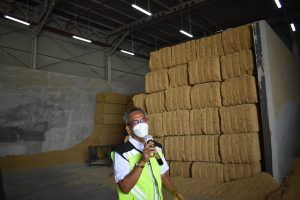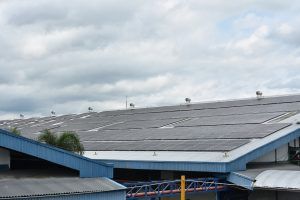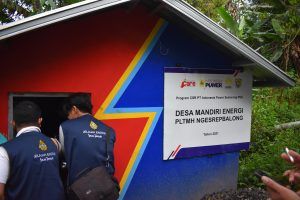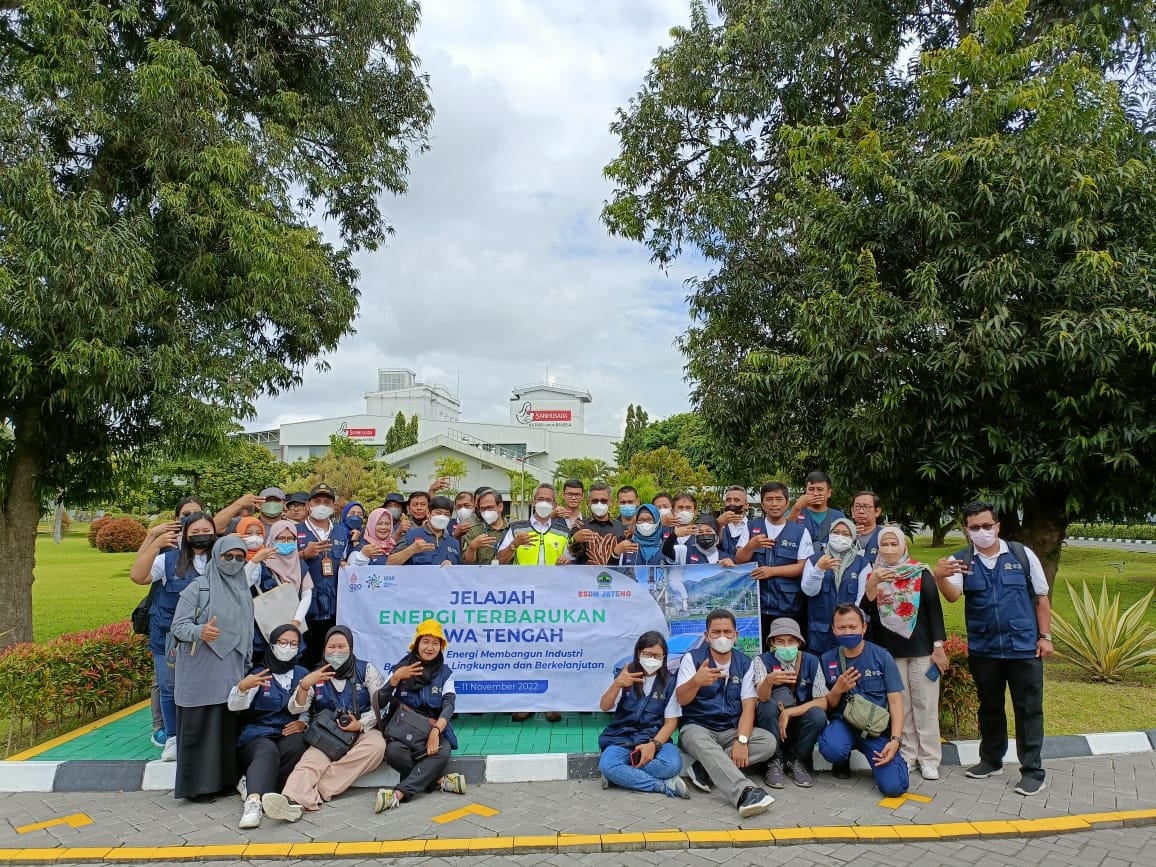Central Java, November 11, 2022 – The Central Java provincial government is committed to supporting and encouraging renewable energy development from the industrial sector to the community level. It can be seen in several companies and villages implementing renewable energy in their environment. Renewable energy is generated from natural processes that are continuously replenished. Renewable energy includes solar, geothermal heat, wind, tides, water, and biomass.
The Central Java Energy and Mineral Resources Department and the Institute for Essential Service Reform (IESR) held the Central Java Energy Exploration for two days, November 10 and November 11, 2022, with the theme “Energy Transition to Build an Environmentally Friendly and Sustainable Industry.” Participants visited two companies and villages implementing renewable energy on the second day, PT. Sarihusada Generasi Mahardhika – Prambanan Factory, PT. Tirta Investama-Klaten Aqua Factory, and Ngesrep Balong Kendal Village PLTMH.
Utilization of Rice Husk as Energy
Sarihusada Generasi Mahardhika – Prambanan Factory inaugurated the construction of a rice husk-fired Biomass Boiler in June 2022. The biomass boiler will use 10,500 tons of rice husk annually and can produce up to 6 tons of steam per hour. With this ability, it’s no wonder this rice husk-fired industrial biomass boiler is claimed to be the first in Central Java.
Rice husk is an agricultural waste sourced from several areas in Central Java Province, including the surrounding agricultural land within this Biomass boiler facility, which is one of the most significant contributors to rice production nationally. Joko Yulianto, Plant Manager of Sarihusada Prambanan Factory, stated that the biomass boiler operated by Sarihusada could reduce carbon emissions by 8,300 tons of CO2 or the equivalent of carbon emissions absorbed through planting 120,000 trees. It also reduces the carbon footprint generated from the production process at the Prambanan Factory by up to 32%.

“Biomass boilers are an alternative to environmentally friendly technology. The energy produced comes from natural renewable sources. In the form of biological elements such as dead organisms or living plants, “explained Joko Yulianto.
The IESR Study 2021 assesses the potential for biomass in Indonesia to reach around 30.73 GW, but the efficiency is still in the range of 20-35 percent. The use of biomass in the industrial sector is becoming increasingly popular with the emergence of sustainable business targets. Therefore it must ensure a reliable supply chain to ensure the availability of biomass sources. Biomass feedstocks include crop residues and other plantation product wastes such as oil palm, coconut, and sugarcane.
Solar Power Plants in the AQUA factory in Klaten

Meanwhile, PT. Tirta Investama-Aqua Factory, Klaten, inaugurated a rooftop solar power plant (PLTS atap) in 2020. The rooftop solar PV installed at the AQUA factory in Klaten consists of 8,340 modules of solar panels in four roof buildings covering an area of 16,550m2, with a peak power of around 350 watts per unit.
“This solar power plants can generate 4 GWh (Gigawatt hour) electricity per year which can supply 15-20% of electricity needs for operations while reducing 3,340 tons of carbon emissions per year. It was built starting in August 2019 and required 187,200 working hours carried out by 130 workers with zero accidents,” said I Ketut Muwaranata, Plant Director AQUA Klaten.
Based on the latest IESR report entitled Indonesia Solar Energy Outlook 2023, the industrial and commercial sectors are the biggest drivers of solar power plant use, reaching up to 23 MWp in October 2022. In addition to sustainable business targets, especially for companies that are members of the RE100 coalition, renewable energy also reduces production costs. Innovative financing schemes, such as the zero-CAPEX offered by many solar PV developers, increase the attractiveness of rooftop PV mini-grid for industrial customers.
In the last three years, the growth of rooftop solar PV users in the industrial sector has increased, and when the 10 to 15 percent limit of capacity currently imposed by PLN continues, this trend will change and even decrease. This is unfortunate and does not support the various energy transition commitments from the government and companies, who cooperate in realizing Indonesia’s net zero emission.
PLTMH Lights Ngesrepbalong Villages’s Road

Based on the 2021 IESR study, the technical potential for micro-mini hydropower in Indonesia reaches 28.1 GW in all Indonesian provinces. In Central Java, the technical potential of micro-mini hydropower comes to 730.3 MW. If this potential is utilized optimally, it will increase the productivity of rural communities, thereby encouraging access to quality and affordable energy and improving the economy and people’s welfare.
The Micro Hydro Power Plant (PLTMH), Ngesrepbalong Village, Kendal Regency, was developed by the youth around 2020 and used for electricity at the Pucue Kendal Coffee shop, which is located on the northern slope of Mount Ungaran. In the process, the village youth got the state-owned company, Indonesia Power, to look at and help their businesses realize independent energy.
The PLTMH in Ngesrepbalong Village, Kendal Regency, has a capacity of around 1,000 watts and can turn on dozens of lights to illuminate the 200-meter road to the coffee shop and turn on the coffee processing equipment in the shop.
The Central Java Energy Exploration event was held to raise the issue of energy transition in Central Java based on the green industry and the Climate Village program. It also disseminates information regarding the urgency of the energy transition to the public, increasing exposure to the green industry and the Climate Village program in Central Java.

